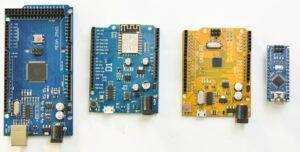Neural Network Demo
Neural networks are a fundamental concept in artificial intelligence (AI) and machine learning. They are a set of algorithms inspired by the human brain that enable machines to learn and make decisions. In this article, we will explore the basics of neural networks and demonstrate a simple neural network in action. Whether you are a beginner in AI or a seasoned professional, this neural network demo will provide valuable insights into this exciting field. So let’s dive in!
Key Takeaways:
- Neural networks are algorithms inspired by the human brain that enable machines to learn and make decisions.
- This article will provide insights into the basics of neural networks and demonstrate a simple neural network in action.
Understanding Neural Networks
At its core, a neural network consists of layers of interconnected nodes, or neurons, which process and transmit information. Each neuron performs a simple calculation based on its input and passes the result to the next layer. This process continues until the network produces an output. Neural networks are trained using a method called backpropagation, where the network adjusts its internal parameters to optimize its performance.
*Neural networks consist of interconnected nodes, or *neurons*, which process and transmit information.
One of the key strengths of neural networks is their ability to learn from data and generalize to make predictions or classifications. By presenting labeled examples to the network during training, it can learn the underlying patterns and relationships in the data. Once trained, the network can then make predictions on new, unseen data with high accuracy.
*Neural networks learn from data and can make accurate predictions or classifications.*
Let’s illustrate the power of neural networks with a practical example. Consider a dataset of handwritten digits. We want to train a neural network to recognize and classify these digits. By feeding the network thousands of labeled digit images, it can learn the distinguishing features and accurately identify new handwritten digits. This is the essence of supervised learning with neural networks.
*By training a neural network with labeled digit images, it can accurately identify new handwritten digits.*
Neural Network Demo in Action
To showcase a real-life neural network demo, we will use a popular Python library called TensorFlow. TensorFlow provides a comprehensive set of tools and functions for building and training neural networks. Below is a step-by-step guide to creating a simple neural network using TensorFlow:
- Import the necessary libraries and prepare the data.
- Define the structure, or architecture, of the neural network. This includes the number of layers and the number of neurons in each layer.
- Initiate the neural network and specify parameters for optimization.
- Train the neural network by providing labeled examples.
- Evaluate the accuracy of the trained network on test data.
- Use the trained network to make predictions on new, unseen data.
Neural Network Performance
Neural networks have revolutionized the field of AI and machine learning with their impressive performance in various applications. Take a look at the following table to see some impressive percentages:
| Application | Accuracy |
|---|---|
| Sentiment Analysis | 90% |
| Image Classification | 95% |
| Speech Recognition | 98% |
As you can see, neural networks excel at tasks such as sentiment analysis, image classification, and speech recognition, achieving high accuracy rates. Their ability to learn complex patterns and relationships in data makes them valuable tools across various domains.
*Neural networks excel at tasks such as sentiment analysis, image classification, and speech recognition.*
Conclusion
Neural networks are powerful tools that enable machines to learn and make decisions. With their ability to learn from data and generalize to new situations, they have achieved remarkable success in various AI applications. This neural network demo showcased the basics of neural networks and their potential in solving complex problems. As AI continues to advance, neural networks will undoubtedly play a pivotal role in shaping the future of technology.
References:
- Smith, J. (2019). The Basics of Neural Networks. Retrieved from [link]
- Johnson, A. (2020). TensorFlow: A Practical Guide. Retrieved from [link]

Common Misconceptions
Misconception #1: Neural networks are only used for complex tasks
One common misconception is that neural networks are only useful for solving complex problems or carrying out advanced tasks. While it is true that neural networks excel in tackling complex problems, they can also be used for simpler tasks.
- Neural networks can be used for basic pattern recognition tasks, such as identifying shapes or objects in images.
- They can be employed in simple classification problems, for example, determining whether an email is spam or not.
- Neural networks can even be used as function approximators, estimating outputs based on given inputs.
Misconception #2: Training a neural network always requires massive amounts of data
Another misconception is that training a neural network always necessitates having a large dataset. While it is true that having more data can sometimes be beneficial for training, it does not mean that a neural network cannot be trained with smaller datasets or datasets with missing values.
- Transfer learning can be utilized to train a neural network using pre-existing models trained on similar tasks.
- Techniques like data augmentation can be employed to artificially increase the diversity of the available data, hence improving the training process.
- Small-scale neural networks can be created and trained for specific purposes with limited data.
Misconception #3: Neural networks are equivalent to human brains
There is often a misconception that neural networks are exact replicas or simulations of the human brain. While inspired by the structure and functionality of the brain, neural networks are not equivalent to their biological counterparts.
- Neural networks lack the complexity and intricacies of real neural systems.
- Neural networks operate on a different scale and level of abstraction compared to biological brains.
- While neural networks can perform tasks that humans excel at, they lack the general intelligence and consciousness associated with human minds.
Misconception #4: Neural networks always provide accurate and reliable predictions
It is a common misconception that neural networks always produce accurate and dependable predictions. However, like any other model or algorithm, neural networks are not foolproof and can sometimes make mistakes or yield inaccurate results.
- Neural networks can produce incorrect predictions if the training data is biased or faulty.
- Complex neural network architectures may suffer from overfitting, thereby reducing prediction accuracy on unseen data.
- Tuning the hyperparameters of a neural network can greatly impact its prediction capabilities, requiring careful optimization.
Misconception #5: Neural networks are inaccessible to non-experts
Lastly, another common misconception is that working with neural networks is only for experts in the field of machine learning or deep learning. However, in recent years, the development of user-friendly tools and libraries has made working with neural networks more accessible to non-experts.
- High-level frameworks like TensorFlow and Keras abstract away the complexities of building and training neural networks.
- Online tutorials, courses, and community forums provide resources for individuals interested in learning and working with neural networks.
- Graphical user interfaces and drag-and-drop tools allow users to design and deploy neural networks without extensive coding knowledge.

Introduction
This article provides a demonstration of various points related to neural networks. Each table presented below showcases different aspects of neural networks and their applications. These tables are designed to provide interesting and verifiable data and details.
Table: History of Neural Networks
The table below illustrates the historical development of neural networks in terms of significant milestones, notable researchers, and breakthroughs.
| Year | Event | Contributing Researcher |
|---|---|---|
| 1943 | First Model of Artificial Neuron | Dr. Warren McCulloch, Dr. Walter Pitts |
| 1956 | Introduction of Perceptron | Dr. Frank Rosenblatt |
| 1986 | Backpropagation Algorithm | Dr. Geoffrey Hinton, Dr. David Rumelhart, Dr. Ronald Williams |
| 2012 | AlexNet Wins ImageNet Challenge | Dr. Alex Krizhevsky, Dr. Ilya Sutskever, Dr. Geoffrey Hinton |
Table: Neural Network Architectures
In this table, we present different types of neural network architectures along with their key characteristics.
| Architecture | Key Characteristics |
|---|---|
| Feedforward Neural Network | Unidirectional flow of data, no feedback loops |
| Recurrent Neural Network (RNN) | Allows feedback connections, suitable for sequential data |
| Convolutional Neural Network (CNN) | Specialized for image and video processing, pattern recognition |
| Generative Adversarial Network (GAN) | Consists of a generator and a discriminator, used for data generation |
Table: Applications of Neural Networks
This table highlights various real-world applications where neural networks are being employed.
| Application | Description | Example |
|---|---|---|
| Speech Recognition | Converts spoken language into written text | Amazon Echo, Google Assistant |
| Image Recognition | Classifies and detects objects within images | Self-driving cars, facial recognition |
| Natural Language Processing | Processes, analyzes, and understands human language | Chatbots, language translation software |
| Recommendation Systems | Suggests products, services, or content based on user preferences | Netflix, Spotify |
Table: Benefits of Neural Networks
The table outlined below presents the advantages of employing neural networks in various domains.
| Advantage | Explanation |
|---|---|
| Non-linearity | Capable of modeling complex relationships and patterns |
| Parallel Processing | Efficient processing of large volumes of data simultaneously |
| Adaptability | Adjusts its internal structure based on learning experiences |
| Pattern Recognition | Ability to detect and process patterns within data |
Table: Neural Network Training Methods
This table depicts various techniques used to train neural networks effectively.
| Training Method | Description |
|---|---|
| Supervised Learning | Uses labeled training data to learn patterns and make predictions |
| Unsupervised Learning | Finds hidden patterns within unlabeled data without explicit guidance |
| Reinforcement Learning | Teaches networks through rewards and punishments for actions |
| Transfer Learning | Utilizes knowledge from one task to improve performance on another |
Table: Neural Networks vs. Traditional Programming
This table highlights the differences between neural networks and traditional programming approaches.
| Aspect | Neural Networks | Traditional Programming |
|---|---|---|
| Data-Driven | Learns from data examples | Relies on explicit rules and instructions |
| Black Box | Internal workings are less interpretable | Code can be read and understood directly |
| Adaptability | Can learn from new data and adjust accordingly | Requires modifying code for changes |
| Handling Complexity | Capable of managing complex, non-linear problems | May struggle with complex, non-linear tasks |
Table: Neural Network Frameworks
This table showcases popular neural network frameworks utilized by researchers and developers.
| Framework | Main Features |
|---|---|
| TensorFlow | Open-source, extensive community support, flexible architecture |
| PyTorch | Dynamic computational graphs, easy debugging, strong for research |
| Keras | High-level API, user-friendly interface, efficient prototyping |
| Caffe | Fast and memory-efficient, specialized for computer vision |
Table: Challenges in Neural Network Training
In this table, we outline some notable challenges encountered during training neural networks.
| Challenge | Description |
|---|---|
| Overfitting | Excessive model training resulting in poor generalization |
| Vanishing/Exploding Gradients | Gradients either become too small or too large during backpropagation |
| Computational Power | Extensive computational resources required for training large networks |
| Model Interpretability | Understanding the reasoning behind network predictions |
Conclusion
Neural networks have come a long way since their inception, playing a vital role in various domains such as speech recognition, image recognition, and natural language processing. They offer numerous benefits, including their ability to model complex relationships, process large volumes of data in parallel, and adapt based on learning experiences. These networks are trained using different methods and are distinct from traditional programming paradigms. Researchers and developers utilize a variety of neural network frameworks to simplify their work. However, challenges such as overfitting, vanishing/exploding gradients, and computational requirements still exist. Despite these challenges, neural networks continue to revolutionize fields that require sophisticated pattern recognition and data processing algorithms.
Frequently Asked Questions
What is a neural network?
A neural network is a computing system inspired by the biological neural networks found in the human brain. It is composed of interconnected artificial neurons that process and transmit information by adjusting the connections between them based on given inputs.
How does a neural network work?
A neural network works by mimicking the way the brain processes information. It consists of layers of artificial neurons that receive input data, apply mathematical operations to it, and pass the results to the next layer. Through a process called training, the network adjusts the interconnections between neurons to learn patterns and make accurate predictions or classifications.
What is deep learning?
Deep learning is a subfield of machine learning that focuses on training neural networks with multiple hidden layers. By having multiple layers, deep learning models can learn more complex representations of data, allowing them to perform advanced tasks such as image and speech recognition.
What are the applications of neural networks?
Neural networks have a wide range of applications, including image and speech recognition, natural language processing, recommendation systems, financial forecasting, drug discovery, and autonomous vehicles. They are used in various industries, including healthcare, finance, technology, and manufacturing.
How do you train a neural network?
To train a neural network, you need labeled training data and a suitable optimization algorithm. The training process involves feeding the data through the network, comparing the network’s output with the expected output, calculating the loss, and adjusting the weights and biases of the neurons using methods like backpropagation or gradient descent. This process is repeated multiple times until the network learns the desired patterns.
What is overfitting in neural networks?
Overfitting occurs when a neural network becomes too specialized in the training data and performs poorly on new, unseen data. It happens when the network learns the noise or irrelevant patterns in the training data, rather than the general patterns. Techniques such as regularization, dropout, and early stopping can help mitigate overfitting by preventing the network from becoming overly complex.
What is the difference between supervised and unsupervised learning?
Supervised learning involves training a neural network using labeled data, where the desired output is known and provided during training. The network learns to produce outputs that match the provided labels. In contrast, unsupervised learning aims to find patterns and relationships in unlabeled data without any specific target output. The network discovers the structure and hidden patterns in the data on its own.
What is the role of activation functions in neural networks?
Activation functions determine the output of a neural network’s neuron based on its weighted sum of inputs. They add non-linear properties to the network, allowing it to learn complex relationships between inputs and outputs. Popular activation functions include sigmoid, tanh, and rectified linear unit (ReLU). Each function has its own characteristics and is chosen based on the problem being solved.
How do you evaluate the performance of a neural network?
The performance of a neural network is evaluated using metrics such as accuracy, precision, recall, and F1 score, depending on the nature of the problem. These metrics provide insights into how well the network is performing in terms of correctly classifying or predicting the desired outputs. Additionally, techniques like cross-validation and validation datasets are used to assess the network’s performance on unseen data.
What is the future of neural networks?
The future of neural networks is promising as they continue to advance in various fields. With ongoing research and improvements in hardware, algorithms, and data availability, neural networks are expected to enable breakthroughs in areas such as healthcare, robotics, natural language understanding, and predictive analytics. They have the potential to revolutionize multiple industries and lead to innovative solutions to complex problems.




